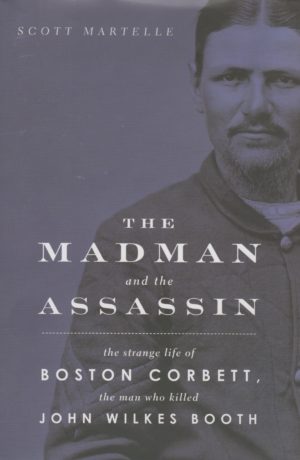
The Madman and the Assassin by Scott Martelle (2015. Chicago Review Press. ISBN 978-1-61373-018-8)
It all started for me, my obsession with Thomas “Boston” Corbett, when I read a menu at Tobie’s Restaurant in Hinckley, Minnesota. How so, you ask? Well there, buried in the stories about the Hinckley Fire (circa 1894) was a very short speculation that the killer of John Wilkes Booth, Boston Corbett, had met a tragic end in Minnesota during the fire. The proof was supposedly some burial or other records related to the fire’s aftermath. Just like the historical figure, Olli Kinkkonen, whose tragic lynching in Duluth propelled my historical novel, Suomalaiset, I thought Maybe Corbett’s story is the beginning of a book…But in the end, that didn’t happen. Instead, I read a bit about Corbett and used his nasty self-castration (a known fact!) as part of The Tyler’s backstory in Laman’s River and pretty much put Boston out of my mind. Until I couldn’t. When you’re OCD, things never truly are forgotten or placed on the shelves of your mind. So in looking at his tale as a potential novel unto itself, I stumbled across an actual biography of the man written by journalist Scott Martelle. The book, finely written and complete, convinced me that Corbett’s story has been told and I need to move on.
Martelle does a marvelous job of giving readers as much factual history as possible about a man who had a tortured and difficult life. In truth, there isn’t a whole lot out there about Corbett that a biographer can grab hold of and turn into a character study. But what is there, this author has woven into a story of Booth and Corbett and their tragic intersection in a rural Washington D.C. barn on that fateful night. Corbett, a cavalryman with the Union during the war, was charged with accompanying a group of soldiers and detectives in their hot pursuit of Booth and his accomplices. Martelle gives us the background-historical and personal-regarding the two main protagonists in that chase. He also explains Corbett’s actions (shooting the assassin when his orders were clearly to take the man into custody) such that there is little doubt the diminutive eunuch was simply doing his duty when he shot Booth.
Additionally, Martelle paints a compelling portrait of the later years of Boston Corbett’s life, highlighting the significant ordeal the former soldier went through to obtain his pension for his years of service during the war and his incarceration as a POW in the notorious Confederate prison at Andersonville. Resisting the opportunity to embellish and speculate regarding Corbett’s reported demise in the Hinckley Fire, Martelle sticks to the facts until this very well done examination of a fascinating character reaches its conclusion.
I’d highly recommend this biography of a compelling, if somewhat demonstrably odd minor figure, in American history to anyone interested in the Civil War, Booth, or their times.
4 and 1/2 stars out of 5. A great book club read!
Peace.
Mark


